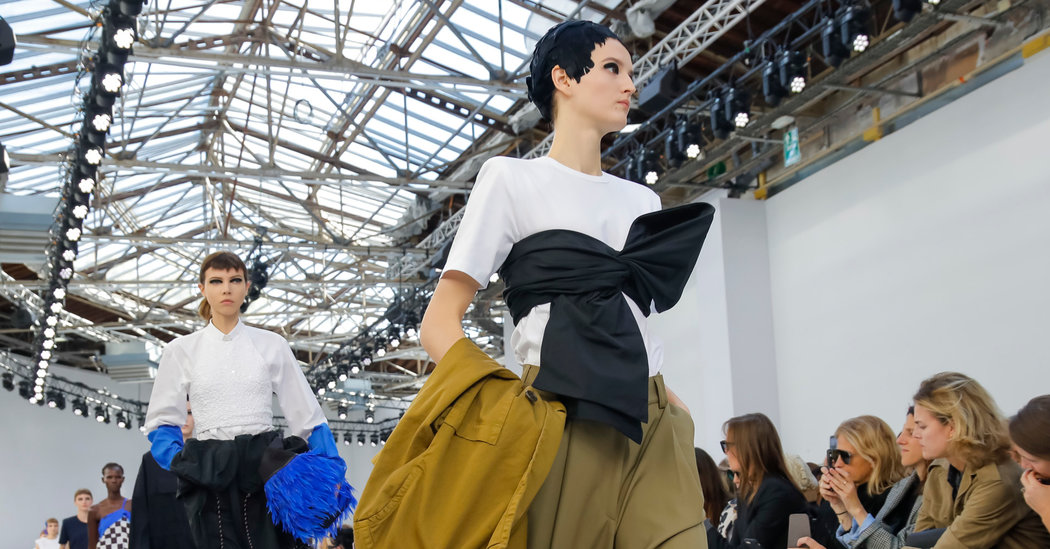
PARIS — On Tuesday night the 19th-century Hôtel de Pontalba on Rue du Faubourg St.-Honoré, the residence of the United States ambassador to France, was aglow with chatter and Champagne, slices of lobster and dabs of foie gras. Jamie D. McCourt was hosting a party in celebration of a new special relationship: that of Google and fashion. The digital giant may be under fire from conservatives, but it is wooing style.
Victoria Beckham was hobnobbing with Amber Valletta, Joseph Altuzarra with Pierre Hardy, Alexandre Arnault with Maria Grazia Chiuri of Dior. Virgil Abloh, taking time off from preparations for his Off-White show the next day, was the D.J. Haim performed and Kendall Jenner and Bella Hadid cheered.
The digital sphere has become its own city-state, and everyone is declaring allegiance.
Or most everyone. It has become so common to talk about shows as online content, conceived to catch the eyes of the generation that lives with a smartphone and all its filters as a bodily extension and blah blah blah, so on and so forth, that it is almost a shock to see a collection made with a three-dimensional woman and not a two-dimensional image in mind. But such was the case with Dries Van Noten, whose clothes managed to be both utterly grounded and a little fantastical at the same time.
Using basic cotton workwear, he wrapped and draped, furled and unfurled it into shapes that gestured toward D.I.Y. Parisian evening gowns. Baggy overalls were rolled down to the waist to create peplums. A taffeta-like trench knotted to create a train. A plain white T-shirt tied with a big black bow around the bust, and paired with slouchy cargo pants. Iridescent nylon anoraks floated over shift dresses dangling plastic feathers. Beaded gold fringe poured down the shoulders of a simple white shirt. There were florals and stripes and checkerboard squares; cobalt blue and sunshine yellow, tangerine and watery emerald green.
They had the clarity and balm of cool air blowing in an open window. Looking at them you could practically hear the birds chirping. Hello, reality! Forgot about you for a moment there.
Perhaps it’s because Mr. Van Noten shows what he sells, which is to say: not simply an idea of how someone might look, but the actual dresses, skirts and suits that express that idea and make it onto the shop floor. It’s harder to combine the two effectively than you might think, especially in these social media-driven days, which is why designers often want showgoers to come back and see what’s in their showrooms: the “wearable” derivations of the more extreme looks they put on the runway, in order to make a statement through a small screen.
Although another solution is to pile everything up willy-nilly so it simply can’t be missed. Witness Natacha Ramsay-Levi at Chloé, who, calling her collection “hippie modernism,” took a virtual van down to the beach at sunset on Ibiza (or Crete or Capri or Essaouira; take your pick), and then pulled an assortment of urban folklore out of her magic trunk.
Paisley and flower power silk scarves sourced from flea markets were remade as bias-cut silk dresses and shorts with flowing pareo “skirts” at the back; sunset shade T-shirts had a shadow print of arms raised in a triangular feminist symbol; tapestry knits became coats; flared silk trousers were finished in silk fringe at the ankles; and pleated Grecian dresses were caught by leather harnesses.
There were big dangling earrings and upper-arm bands and toe rings; knotted rope belts and chunky clogs; a whole lot of bags and a bit of sleight of hand. Look closer, and the faded denim jeans and shirt were actually trompe l’oeil silk; a pair of basket-woven pants, perforated leather; what seemed to be semiprecious stones on a vest, in fact, man-made simulacra.
Crafty, in other words, in a whole variety of connected ways. And you didn’t really have to search for them.







